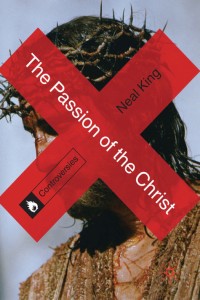The Passion of the Christ
The Passion of the Christ by Neal King (Palgrave Macmillan, 2011), 148 pages, ISBN: 978-0230294349 (paperback), Price: £12.99
 About the reviewer: Dr Catherine O’Brien is Senior Lecturer in Film Studies and French at Kingston University. Her publications include: The Celluloid Madonna: from Scripture to Screen (2011) ; Women’s Fictional Responses to the First World War: a comparative study of selected texts by French and German writers (1997); and as editor, with Fran Lloyd, Secret Spaces, Forbidden Places: rethinking culture (2000); and ‘Mary in film’ in Sarah Jane Boss (ed.) Mary: The Complete Resource (2007).
About the reviewer: Dr Catherine O’Brien is Senior Lecturer in Film Studies and French at Kingston University. Her publications include: The Celluloid Madonna: from Scripture to Screen (2011) ; Women’s Fictional Responses to the First World War: a comparative study of selected texts by French and German writers (1997); and as editor, with Fran Lloyd, Secret Spaces, Forbidden Places: rethinking culture (2000); and ‘Mary in film’ in Sarah Jane Boss (ed.) Mary: The Complete Resource (2007).
The inclusion of a film about Jesus Christ in Palgrave Macmillan’s new Controversies series – alongside A Clockwork Orange (1971), Straw Dogs (1971) and Henry: Portrait of a Serial Killer (1986) – may seem a contentious move in itself. However, Neal King’s in-depth study of Mel Gibson’s The Passion of the Christ (2004) ably underlines the controversial status of ‘the most successful independently produced film ever screened in the United States’ (p.49). In an appended personal note, the author explains that he treats religion as an object of scientific study, and he offers fascinating perspectives on the film’s two most polemical aspects: the portrayal of the Jewish characters and the level of onscreen violence.
 Locating his argument within a broader examination of perceived anti-Semitism in New Testament films, King reflects on the conflict between Gibson’s Icon Productions company and a group of Catholic and Jewish scholars (led by Eugene Fisher, an expert on interfaith relations) as ‘an initially unplanned spiral of events that built defensiveness on both sides’ (p.3) and aided the film’s marketing campaign. While he presents different facets of the dispute, he later includes a close analysis of scenes involving Pilate and Caiaphas that promote the author’s own view that ‘attempts to deny that Pilate is portrayed as sympathetic are disingenuous’ (p.100).
Locating his argument within a broader examination of perceived anti-Semitism in New Testament films, King reflects on the conflict between Gibson’s Icon Productions company and a group of Catholic and Jewish scholars (led by Eugene Fisher, an expert on interfaith relations) as ‘an initially unplanned spiral of events that built defensiveness on both sides’ (p.3) and aided the film’s marketing campaign. While he presents different facets of the dispute, he later includes a close analysis of scenes involving Pilate and Caiaphas that promote the author’s own view that ‘attempts to deny that Pilate is portrayed as sympathetic are disingenuous’ (p.100).
Given that the furore over anti-Semitism has been assiduously investigated elsewhere, some readers will find the book’s section on film classification to be the most illuminating. As King demonstrates, the scenes of extensive bloody torture received an R-rating in the United States and an 18 classification in the UK, but in Japan received only a PG-12 certificate. In exploring the film’s rating in New Zealand (R16, reduced on appeal to R15) and making comparisons with Saving Private Ryan (1998), King extends the debate to consider the role that historical, artistic and religious significance plays in censorship considerations. Pointing out that Evangelicals accepted onscreen violence that they would have denounced under other circumstances, King also argues that the religious dimension of Gibson’s film led boards of review in several countries to bend the rules and grant it a wider release.
One of the most intriguing sections of the text is the examination of the post 9/11 climate, when the sense of the United States as a ‘Christian nation’ was heightened after the terrorist attacks. King scrutinises film violence in the wake of World War 2 and Vietnam, claiming that ‘wartime focus on actual death twice served as licence for studios to market bloodshed on screen’ (p.32) and pondering whether the War on Terror provided a similar climate for a film released in 2004.
Readily admitting that his work was hampered by lack of access to files (both at Icon and the Motion Picture Association of America) that would shed more light on its production and certification, King acknowledges that his use of the words ‘presumably’ and ‘apparently’ indicates a degree of guesswork. However, the absence of such documentation does not detract from the substantial nature of King’s research, given that there is so much relevant information in the public domain. Nevertheless, students interested in a more thorough reading of the film’s challenging theological aspects (which are beyond King’s remit) will need to look elsewhere, including one book not listed in the already lengthy Bibliography: Monica Migliorino Miller’s The Theology of The Passion of the Christ (2005).
King does not shy away from adding to the controversy himself, describing American Evangelicals as a ‘subculture’ and making the bold statement that the film ‘has altered the meaning of the central symbol of Christendom’ (p.x), two observations that require further interrogation. However, he also cites the desire expressed by Professor Mary Boys of the Union Theological Seminary that the uproar stirred by the film is an opportunity to ‘stimulate dialogue, education, shared Scriptural study, and mutual respect’ (p.15). It is to be hoped that King’s monograph will contribute to that aim.
Dr Catherine O’Brien

 Learning on Screen
Learning on Screen